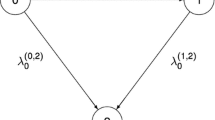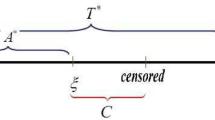Abstract
As an alternative to the Cox model, the rank-based estimating method for censored survival data has been studied extensively since it was proposed by Tsiatis [Tsiatis AA (1990) Ann Stat 18:354–372] among others. Due to the discontinuity feature of the estimating function, a significant amount of work in the literature has been focused on numerical issues. In this article, we consider the computational aspects of a family of doubly weighted rank-based estimating functions. This family is rich enough to include both estimating functions of Tsiatis (1990) for the randomly observed data and of Nan et al. [Nan B, Yu M, Kalbfleisch JD (2006) Biometrika (to appear)] for the case-cohort data as special examples. The latter belongs to the biased sampling problems. We show that the doubly weighted rank-based discontinuous estimating functions are monotone, a property established for the randomly observed data in the literature, when the generalized Gehan-type weights are used. Though the estimating problem can be formulated to a linear programming problem as that for the randomly observed data, due to its easily uncontrollable large scale even for a moderate sample size, we instead propose a Newton-type iterated method to search for an approximate solution of the (system of) discontinuous monotone estimating equation(s). Simulation results provide a good demonstration of the proposed method. We also apply our method to a real data example.

Similar content being viewed by others
References
Borgan Ø, Langholz B, Samuelsen SO, Goldstein L, Pogoda J (2000) Exposure stratified case-cohort designs. Lifetime Data Anal 6:39–58
Breslow NE, McNeney B, Wellner JA (2003) Large sample theory for semiparametric regression models with two-phase, outcome dependent sampling. Ann Stat 31:1110–1139
Fygenson M, Ritov Y (1994) Monotone estimating equations for censored data. Ann Stat 22:732–746
Horvitz DG, Thompson DJ (1952) A generalization of sampling without replacement from a finite universe. J Am Stat Assoc 47:663–685
Huang Y (2002) Calibration regression of censored lifetime medical cost. J Am Stat Assoc 97:318–327
Jin Z, Lin DY, Wei LJ, Ying Z (2003) Rank-based inference for the accelerated failure time model. Biometrika 90:341–353
Kalbfleisch JD, Prentice RL (2002) The statistical analysis of failure time data, 2nd edn. John Wiley & Sons, Inc., New Jersey
Lin DY, Geyer CJ (1992) Computational methods for semiparametric linear regression with censored data. J Comput Graph Stat 1:77–90
Lin DY, Wei LJ, Ying Z (1998) Accelerated failure time models for counting processes. Biometrika 85:605–618
Nan B, Yu M, Kalbfleisch JD (2006) Censored linear regression for case-cohort studies. Biometrika (to appear)
Ortega JM, Rheinboldt WC (1970) Iterative solution of nonlinear equations in several variables. Academic Press, Inc., New York
Prentice RL (1986) A case-cohort design for epidemiologic cohort studies and disease prevention trials. Biometrika 73:1–11
Ritov Y (1990) Estimation in a linear regression model with censored data. Ann Stat 18:303–328
Self SG, Prentice RL (1988) Asymptotic distribution theory and efficiency results for case-cohort studies. Ann Stat 16:64–81
Stewart GW (1996) Afternotes on numerical analysis. SIAM
Taylor JMG, Yu M, Sandler HM (2005) Individualized predictions of disease progression following radiation therapy for prostate cancer. J Clin Oncol 23(4):816–825
Tsiatis AA (1990) Estimating regression parameters using linear rank tests for censored data. Ann Stat 18:354–372
Ying Z (1993) A large sample study of rank estimation for censored regression data. Ann Stat 21:76–99
Acknowledgment
We thank Drs. Howard M. Sandler and Jeremy M. G. Taylor for providing the prostate cancer data.
Author information
Authors and Affiliations
Corresponding author
Appendices
Appendix I
Proof of (3.6)
To evaluate the difference between \(\widetilde{S}_n(\beta, W_n,{\varvec{\xi}})\) and \(\widetilde{S}_n(\beta^{+}, W_n,{\varvec{\xi}})\), it helps to see how \(\widetilde{\mathcal{R}}_{(i)}^{\beta^{+}}\) changes when β changes to β+. To simplify notation, we replace \(n_{\mathcal{C}_{\mathcal{D}}}\) by n and still keep its meaning as the number of completely observed subjects.
Apparently,
where
To simplify the calculation, we use
which will not affect the conclusion since \(\sum^n_{j=1} \rho_j\) is a constant.
Now write \(\widetilde{S}_n(\beta,W_n, \varvec{xi})\) and \(\widetilde{S}_n(\beta^+,W_n, \varvec{xi})\) as
and
Denote
Then by utilizing the changes in risk sets and labels as listed in (3.2), (3.3) and (7.1), (7.2), we can write \(\widetilde{S}_n(\beta,W_n, {\varvec{\xi}})\) as
Similarly,
Hence subtract (7.6) from (7.7) and by R i ρ i = ρ i for all i, we obtain
Appendix II
Convergence of the hybrid Newton algorithm for the univariate case
Because \(\widetilde{S}_n(\beta)\) is a right-continuous step function of β, usually there is no formally defined root. Let the interval [a,b) corresponds to the two consecutive segments of \(\widetilde{S}_n(\beta)\) just below and above the horizontal axis, which contains the point where \(\widetilde{S}_n(\beta)\) changes its sign. Then any point in [a,b) can be defined as a “root” of \(\widetilde{S}_n(\beta)\). A very special situation that rarely occurs is that [a,b) corresponds to the segment where \(\widetilde{S}_n(\beta)=0\). The following Proposition A1 shows that the proposed algorithm yields an “approximated solution” that is close to or inside the interval [a,b) due to the monotonicity of \(\widetilde{S}_n(\beta)\). We do not consider the rate of numerical convergence here because it usually requires assumptions for second derivatives of the evaluated function in Newton type algorithms (see e.g., Stewart 1996). The number of iterations, however, is bounded in the worst scenario by the sample size n under the following assumption (7.8), which can be easily seen from the following proposition because the number of jumps of \(\widetilde{S}_n(\beta)\) is bounded by n.
Proposition A1
Suppose
for a small value ε > 0, then the hybrid Newton algorithm given in Sect. 5 will stop at k-th iteration for a finite k where \(|\widetilde{S}_n(\beta^{(k)})| < \epsilon\).
Proof
Because \(\widetilde{S}_n(\beta)\) is a step function with finite number of steps for a given sample size n, the stopping criterion \(|\widetilde{S}_n(\beta^{(k)})| < \epsilon\) will be achieved for some finite k if the following inequalities hold for any m prior convergence:
We now show that the above inequalities in (7.9) always hold following the updating rules (5.5) and (5.6). Because \(|\widetilde{S}_n(\beta)|\) is a non-decreasing function and the slope in (5.5) is always positive, if β(m+1) is obtained from (5.5), then we must have \(|\widetilde{S}_n(\beta^{(m+1)})| < |\widetilde{S}_n(\beta^{(m)})|\), which implies (7.9).
If β(m+1) is obtained from (5.6) and both \(\widetilde{S}_n(\beta^{(m+1)})\) and \(\widetilde{S}_n(\beta^{(m)})\) have the same sign, then we have either \(|\widetilde{S}_n(\beta^{(m+1)})| < |\widetilde{S}_n(\beta^{(m)})|\) that implies (7.9), or \(|\widetilde{S}_n(\beta^{(m+1)})| = |\widetilde{S}_n(\beta^{(m)})|\) with β(m+1) be the left-end of the interval where the above equality holds due to the right-continuity of \(\widetilde{S}_n(\beta)\). For the latter, no matter β(m+2) is obtained from (5.5) or (5.6), we must have \(|\widetilde{S}_n(\beta^{(m+2)})| < |\widetilde{S}_n(\beta^{(m+1)})|\), thus (7.9) holds.
If β(m+1) is obtained from (5.6), but \(\widetilde{S}_n(\beta^{(m+1)})\) and \(\widetilde{S}_n(\beta^{(m)})\) have different signs, then either \(|\widetilde{S}_n(\beta^{(m+1)})| < |\widetilde{S}_n(\beta^{(m)})|\) when the updating is from the second option in (5.6), or both β(m) and β(m+1) are inside the interval [a,b) when the updating is from the first option in (5.6). For the former case, (7.9) holds; for the latter case, we must have \(|\widetilde{S}_n(\beta^{(m+1)})| = \min_\beta|\widetilde{S}_n(\beta)| < \epsilon\) by assumption (7.8) and hence achieve convergence. The case that \(\widetilde{S}_n(\beta^{(m+1)}) = 0\) is trivial. We thus have completed the proof.
Note: If assumption (7.8) does not hold, in other words, the pre-specified small value ε is too small for a given data set, then the algorithm can never achieve convergence. However, for a large enough maximum allowed iteration number, the algorithm will jump around a few fixed points after certain iteration. These fixed points should be inside the interval [a,b) for the univariate case, and any of them can be claimed as a “root” of \(|\widetilde{S}_n(\beta)|\). Similar phenomenon exists for the multivariate case. So it is necessary to set a maximum iteration number for the algorithm to avoid possible dead loop, and it is also useful to print out the results of the final several steps if the maximum iteration number is exceeded.
Rights and permissions
About this article
Cite this article
Yu, M., Nan, B. A hybrid Newton-type method for censored survival data using double weights in linear models. Lifetime Data Anal 12, 345–364 (2006). https://doi.org/10.1007/s10985-006-9014-0
Received:
Accepted:
Published:
Issue Date:
DOI: https://doi.org/10.1007/s10985-006-9014-0




